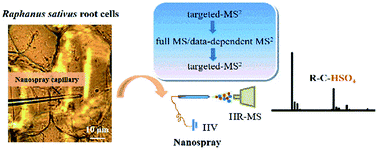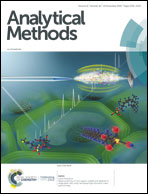Rapid screening of new organic sulfates and alkaloids in single plant cells using nanospray high-resolution mass spectrometry†
Abstract
In this work, a method for the rapid screening of bioactive compounds with characteristic groups in single plant cells has been developed using nanospray high-resolution mass spectrometry (HR-MS). A nanospray capillary was used for single cell sampling and ionization analysis. The screening method was built on the fact that some metabolites were species-specific, which contained common chemical moieties, and the common fragment ions can be produced from them in mass spectrometry. Therefore, new metabolites with common chemical moieties can be screened out by tracing the daughter ions in targeted-MS2 spectra. Using this method, nineteen bioactive compounds in plant cells were identified, fourteen of which were newly discovered compounds, such as organic sulfated compounds (R–HSO4) in Raphanus sativus root and solanine alkaloids (R–C27H42NO) in potato sprouts. Without pretreatment and chromatographic separation, the method realizes systematic screening of bioactive compounds in plant cells and retains the original information of samples to the greatest extent. More importantly, the established method shows great potential in the discovery of new bioactive compounds especially labile compounds in single-cell metabolomics.



 Please wait while we load your content...
Please wait while we load your content...